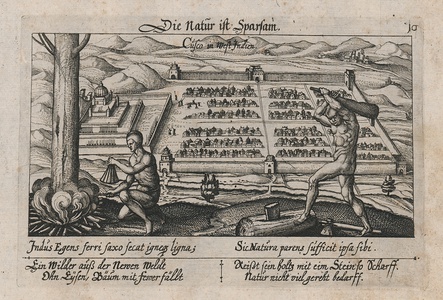| Method | Copper engraving |
| Artist | Daniel Meisner |
| Published | [Eberhard Kieser, Frankfurt, c.1623-1631] |
| Dimensions | Image 94 x 140 mm, Plate 98 x 150 mm, Sheet 138 x 180 mm |
| Notes |
A view of Cusco in Peru, behind a vignette of two Inca labourers felling and splitting wood, from the seventh part of Daniel Meisner's Thesaurus philo-politicus, with verses inscribed in Latin and German below and the number 10 in the upper right. The title of the emblem, above the image, reads: Die Natur ist Sparsam - 'Nature is economical.' A description elaborating on the moral is included directly below the image in Latin: Indus Egens ferri saxo secat ignesque ligna. Sic Natura parens sufficit ipsa sibi - 'The Indian, needful of iron, fells wood with stone and fire. Thus Mother Nature suffices for herself' Meisner's emblem book, containing over 800 pictorial-poetic compositions, was enormously popular throughout Europe in the 17th century. The plan views were based on the work of De Bry, Braun & Hogenberg, Merian and others with the addition of emblematic figures or scenes in the foreground, juxtaposed with moralising and edifying verses beneath the image and a Latin motto at top. It was originally issued in parts, with each part having 52 plates, as the Thesaurus philo-politicus in 1623-24. After Meisner's death in 1625, Eberhard Kieser, with assistance from Johann L. Gottfried, completed the work and published it until 1631. The plates then appeared in the eight parts of Sciographia Cosmica published by Paulus Furst between 1638-78. The plates for these editions were renumbered alpha-numerically in the upper right corners - A-H (identifying the 8 parts) and 1-100 (plate number). They were finally issued in 1700 and 1704 in Rudolf J. Helmer's Politica-politica. Condition: Foxing and dirt staining to margins. Blank on verso. |
| Framing | unmounted |
| Price | £200.00 |
| Stock ID | 52789 |

